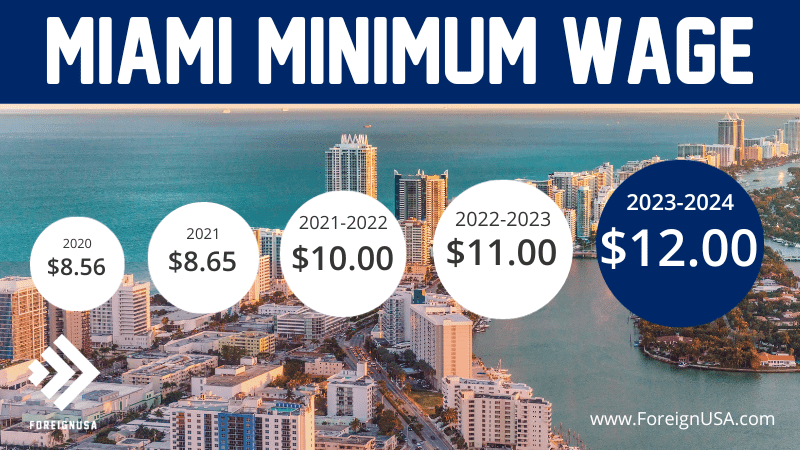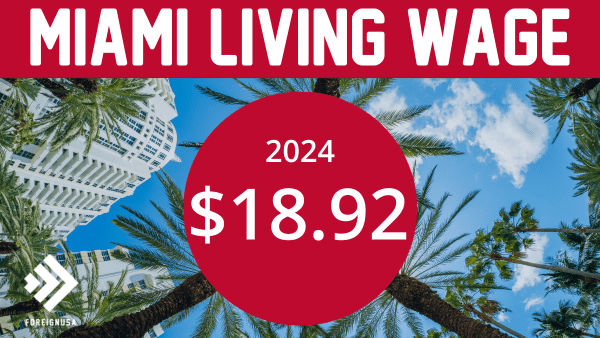The minimum wage in Miami, Florida, is $12.00 per hour in late 2023 and for the vast majority of 2024, ending on September 30, 2024.
People come to Miami from all over for business and pleasure. The city is a hotbed for cultures from all over the world and has a world-class economy.
The heavy Latin influence gives the city a colorful and energetic vibe, and with the constant hot weather and awesome beaches, you really do feel like you are in another country.
Heavy tourism and a pro-business approach taken by the local government have helped the iconic city reach new economic heights and become even more attractive to move to for work and business.
With Miami, you are getting an unmatched quality of life and an abundance of employment and entrepreneurial opportunities.
The following graphic displays the Miami minimum wage rate over the past several years, which has been increasing at a consistent and gradual rate each year.
If you scroll to the bottom of the page, we have included a table that shows you the history of the Miami minimum for every year since 1983.

The weekly minimum wage in Miami equates to $480 ($11×40) if you are working a full 40-hour week.
There are, however, some exceptions to this hourly wage for student workers, tipped employees, and overtime workers, who may all receive different minimum wage rates.
Miami Minimum Wage Exemptions
There are rules and laws in place to ensure that employers are paying their employees the minimum wage or above in Miami, Florida unless they are exempt employees.
In late 2021, the Mayor of Miami increased the minimum wage for those working at food and retail vendors to $17.62 per hour.
Below are the other minimum wage rates for exempt employees in Miami FL:
- Miami’s minimum wage for tipped employees is $8.98 per hour with a tip credit rate of $3.02.
- Student-workers (full-time high school or college) in Miami are paid a minimum wage of $10.20 per hour for up to 20 hours of work a week. Any more than this, and they are eligible for the full minimum wage of $12 per hour.
- The overtime minimum wage in Miami is $18 per hour for every hour worked in excess of 40 hours per week.
- The minimum wage for employees under the age of 20 is $4.25 per hour for the first 90 days of employment. After this, they are eligible for the Miami minimum wage rate of $12 per hour.
What is the Miami Living Wage?
Due to Miami being a large and highly populated city, with a large consumer market and competitive job market, you would imagine that the minimum wage rate for the city would be higher than $12 per hour, but for many, it isn’t any higher than this.
However, there is a ‘living wage’ for Miami, which is calculated based on how much a person needs to pay their bills, food, and general cost of living expenses while living in the city.
The living wage for an adult living alone with no children in Miami (Miami-Dade County) is $18.92 per hour (via Living Wage Calculator), which is $6.92 higher than the minimum wage for the state itself.

Fortunately, certain employers in Miami take this into account when they contemplate how much they should be paying employees within the city.
Taking all of the living expenses into account, the living wage annual salary (for a full-time person) in Miami is $39,353.60 before state income tax in Florida.
Miami Living Wage for 1 Adult
Below is a table representing the living wage in Miami for a single adult, with different living wages for the additional amount of children they live with and care for.
| Single Adult | 0 Children | 1 Child | 2 Children | 3 Children |
|---|---|---|---|---|
| Living Wage | $18.92 | $37.63 | $47.03 | $61.87 |
| Poverty Wage | $6.53 | $8.80 | $11.07 | $13.34 |
Miami Living Wage for 2 Adults
The table below showcases the living wage in Miami for 2 adults with only one working, including the costs for the different numbers of children.
| 2 Adults (1 working) | 0 Children | 1 Child | 2 Children | 3 Children |
|---|---|---|---|---|
| Living Wage | $29.34 | $36.57 | $41.34 | $46.92 |
| Poverty Wage | $8.80 | $11.07 | $13.34 | $15.61 |
What is the Average Wage in Miami?
Now that we know the minimum wage, exemptions, and the cost of living, or living wage in Miami, let’s dive in and look at what the average wage is for employees in Miami.
According to Zippia.com, the average base hourly rate is approximately $21.15 per hour in Miami. If you worked full-time (40 hours per week or 2080 hours per year), the average annual income would be approximately $43,992.
So, as an employee in Miami, you have a good chance of being paid a higher wage than the minimum wage of $12.00 per hour.
If the living wage in Miami is $18.92 in 2023/2024 and the average salary equates to an effective hourly rate of $21.15 per hour, Miami is a great choice for those seeking a move to the Sunshine State if they can find the right pay job.
It is important to note that the average wage in Miami is just an average calculation, and you could certainly earn more than this when moving to the state.
However, you may be paid even less, with the minimum wage being $12.00 per hour, which is the case for many Servers in Florida.
Additionally, if the living wage in Miami or perhaps the average does not suit you or your personal requirements and needs, we have created other Florida city minimum wage pages such as the minimum wage in Tampa that you can check out.
Miami Minimum Wage Increase Schedule
Miami had the first increase in its minimum wage per the state’s 2020 constitutional amendment on September 30, 2022.
The second increase took place on September 30, 2023, when it increased from $11.00 per hour to $12.00 per hour.
This voter-approved amendment will continue to increase in future years as follows:
- September 30, 2024: $13 per hour
- September 30, 2025: $14 per hour
- September 30, 2026: $15 per hour
- Beyond 2026: Inflation-linked increases
Miami Minimum Wage History
The table below displays the historical minimum wage rates in Miami, Florida, since 1983. As you can see, the table also includes percentage increases as well as the dollar increase per year.
| Florida City | Minimum Wage | Year | $ Wage Increase | % Increase |
|---|---|---|---|---|
| Miami | $12.00 | 2023-2024 | $1.00 | 9% |
| Miami | $11.00 | 2022-2023 | $1.00 | 10% |
| Miami | $10.00 | 2021-2022 | $1.35 | 15.6% |
| Miami | $8.65 | 2021 | $0.09 | 1.05% |
| Miami | $8.56 | 2020 | $0.10 | 1.2% |
| Miami | $8.46 | 2019 | $0.21 | 2.5% |
| Miami | $8.25 | 2018 | $0.15 | 1.8% |
| Miami | $8.10 | 2017 | $0.05 | 0.6% |
| Miami | $8.05 | 2016 | $0 | 0% |
| Miami | $8.05 | 2015 | $0.12 | 1.5% |
| Miami | $7.93 | 2014 | $0.14 | 1.8% |
| Miami | $7.79 | 2013 | $0.12 | 1.6% |
| Miami | $7.67 | 2012 | $0.36 | 4.9% |
| Miami | $7.31 | 2011 | $0.06 | 0.82% |
| Miami | $7.25 | 2010 | $0 | 0% |
| Miami | $7.25 | 2009 | $0.46 | 6.8% |
| Miami | $6.79 | 2008 | $0.12 | 1.8% |
| Miami | $6.67 | 2007 | $0.27 | 4.22% |
| Miami | $6.40 | 2006 | $1.25 | 24.27% |
| Miami | $5.15 | 2005 | $0 | 0% |
| Miami | $5.15 | 2004 | $0 | 0% |
| Miami | $5.15 | 2003 | $0 | 0% |
| Miami | $5.15 | 2002 | $0 | 0% |
| Miami | $5.15 | 2001 | $0 | 0% |
| Miami | $5.15 | 2000 | $0 | 0% |
| Miami | $5.15 | 1999 | $0 | 0% |
| Miami | $5.15 | 1998 | $0 | 0% |
| Miami | $5.15 | 1997 | $0.40 | 8.42% |
| Miami | $4.75 | 1996 | $0.50 | 11.76% |
| Miami | $4.25 | 1995 | $0 | 0% |
| Miami | $4.25 | 1994 | $0 | 0% |
| Miami | $4.25 | 1993 | $0 | 0% |
| Miami | $4.25 | 1992 | $0 | 0% |
| Miami | $4.25 | 1991 | $0.45 | 11.84% |
| Miami | $3.80 | 1990 | $0.45 | 13.43% |
| Miami | $3.35 | 1989 | $0 | 0% |
| Miami | $3.35 | 1988 | $0 | 0% |
| Miami | $3.35 | 1987 | $0 | 0% |
| Miami | $3.35 | 1986 | $0 | 0% |
| Miami | $3.35 | 1985 | $0 | 0% |
| Miami | $3.35 | 1984 | $0 | 0% |
| Miami | $3.35 | 1983 | $0 | 0% |
Final Thoughts
The minimum wage in Miami in 2024 is the same rate as the Florida state minimum wage, following an hourly wage of $12.00 per hour.
As an employee in Miami, you must be paid this wage or higher by law.
The living wage is significantly higher than the minimum wage within the city, which is why several Miami employers will pay more than $12.00 per hour to their employees despite not being legally obliged to.


